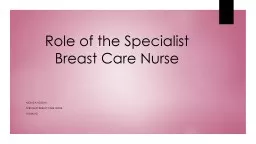

Role of the Breast Care Nurse Free service public or private health system A central contact point throughout your cancer experience Provide uptodate information Provide practical and emotional support ID: 932221
Download Presentation The PPT/PDF document "Role of the Community Specialist Breast ..." is the property of its rightful owner. Permission is granted to download and print the materials on this web site for personal, non-commercial use only, and to display it on your personal computer provided you do not modify the materials and that you retain all copyright notices contained in the materials. By downloading content from our website, you accept the terms of this agreement.
Slide1
Role of the Community Specialist Breast Care Nurse
Slide2Role of the Breast Care Nurse
Free service - public or private health system
A
central contact point throughout your cancer experience
Provide up-to-date information
Provide practical and emotional support
Act as a ‘sounding board’ to discuss options
Referral to other services as required
Act as a link with support
groups
and other support
networks
Slide3How to Refer to Breast Care Nurse
Self
General Practitioner
Surgeon
Medical/ Radiation Oncologist
Nurses
Hospital
Breast Screen NSW
MDT
Slide4What happens next?
Phone client to arrange possible meeting.
Face to face meeting at place of client choosing.
In-patient contact
Post discharge
Pre adjuvant treatment
Post completion of active treatment
Ongoing support as required
Slide5Multidisciplinary
Team Meetings
Local Medical Officers
Surgeons
Radiologists
Radiation Oncologist
Medical Oncologist
Pathologist
Specialist Breast Care Nurses
Genetic Counsellor
Physiotherapist
Social Worker
Slide6Support Services
Prosthesis -Medicare Funded up to $400, every 2 years
Breast Cancer Network- My Journey Kit & My Care Kit
Social Workers- case conference, financial and legal concerns, counselling
The Cancer Council NSW
Genetic Counselling
Breast cancer support groups in
Ballina
, Byron Bay, Casino,
Kyogle
, Lismore and
Murwillumbah
.
Look Good Feel Better
Workshops
Wig Library - NNSWCI
Slide77
Even more support services…
Encore- gentle exercise program after breast cancer
Lymphoedema Therapists (public and private). Located in Lismore, Ballina,
Casino and
Byron Bay
Patient Assisted Travel (IPTAAS). For patients who need to access specialist services 70km or more from home or >200km in a week.
Volunteer (community) transport
Rainbow Dragons Abreast – Lennox & Mount Warning groups
CanTEEN
- support to 12 to 24 year olds
Knockers, bags, pillows, beanies……..
Slide8Anatomy Of the breast
A - Ducts
B – Lobule
C – Lactiferous Duct (holds milk)
D – Nipple
E – Fat
F –
Pectoralis
major muscle
G – Chest wall / rib cage
A – Normal Duct
B – Basement membrane
C – Lumen
(
BreastCancer.org, 2012)
Slide9Triple
T
est
Clinical
examination &
history
Mammogram
Ultrasound +/-
stereotactic core
biopsy
9 out of 10 lumps are benign in Pre-Menopausal women
3 out of 4 lumps are benign in Post- Menopausal women
Slide10Types of breast cancer
An abnormal cell growth that begins & remains within or
insitu
(non- invasive) is called:
Duct = DCIS or Ductal Carcinoma
Insitu
Lobule = LCIS or Lobular Carcinoma
Insitu
(
AIHW & Cancer Australia, 2012)
Slide11Types of breast cancer continued
An abnormal cell growth that NO longer remains
within the duct/lobe
is called invasive or infiltrating;
IDC = Infiltrating Ductal Carcinoma (most common breast cancer)
ILC = Infiltrating Lobular Carcinoma
(
AIHW & Cancer Australia, 2012)
Slide12Less common breast cancers
Inflammatory
breast cancer
A
rare form of invasive breast cancer which affects the lymphatic vessels in the skin of the breast making the skin become red &
inflamed.
often thought to be
cellulitis/mastitis
(
Yarbro
,
Wujcik
&
Gobel
, 2011)
Slide13Paget’s Disease –
affects the nipple and the areola & often associated with invasive cancer elsewhere in the breast.
Slide14Surgical Options for Breast Cancer
Wide Local Excision (WLE
) -
the removal of the breast lump with good clear tissue margins while conserving the breast
Simple Mastectomy - the
removal of the breast
Slide15Lymph Node status
Is necessary for diagnostic, prognostic and therapeutic purposes in order to;
Classify the extent of disease
Planning adjuvant treatment such as chemotherapy, radiotherapy, endocrine treatment
Slide16A-
Pectoralis
major muscle
B- Axillary lymph nodes Level l
C – Axillary lymph nodes level
ll
D – Axillary lymph nodes level
lll
E – Supraclavicular lymph nodes
F internal mammary lymph nodes
(BreastCancer.org, 2012)
Breast area lymph nodes
Slide17Sentinel lymph node
biopsy
Slide18Axillary lymph node dissection
Standard surgical practice
when:
Lymph nodes are clinically palpable
Depending on level of clearance, approximately 10 - 50 lymph nodes may be removed
Slide19Slide20Slide21THANK
YOU